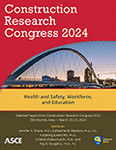Towards an EEG-Based Approach for Detecting Falls from Height Hazards Using Construction Workers’ Physiological Signals
Publication: Construction Research Congress 2024
ABSTRACT
Falls from height (FFH) are the leading cause of fatalities in construction. Traditional methods for detecting FFH hazards have great limitations due to workers’ desensitized risk perception or supervisors’ subjective inspection. Electroencephalogram (EEG) provides an objective metric for overcoming the limits. Early hazard detection can be facilitated by measuring individual physiological states, exhibiting atypical patterns when workers face risks. Although previous work covered hazard detection using EEG, there is a scarcity of FFH-specific emphasis. How to determine appropriate EEG features for detecting FFH hazards was still not discussed. Therefore, this paper evaluated the validity of an EEG-based approach for detecting FFH hazards by establishing five supervised machine learning models. EEG data was collected from 20 front-line construction workers. Two EEG feature selection techniques were included, and performances of five classifiers were compared. Support vector machine was found to have the best overall classification performance for FFH hazard detection when using the filter-based feature selection approach, with a high accuracy of 79.20%. Adopting the proposed approach has the potential to bring managerial benefits in proactive safety management. It sheds light on the development of an early warning system through real-time monitoring of physiological states of construction workers while working at height.
Get full access to this article
View all available purchase options and get full access to this chapter.
REFERENCES
Ahn, C. R., Lee, S., Sun, C., Jebelli, H., Yang, K., and Choi, B. (2019). “Wearable sensing technology applications in construction safety and health.” J. Constr. Eng. Manage., 145(11), 03119007.
Choo, H., Lee, B., Kim, H., and Choi, B. (2023). “Automated detection of construction work at heights and deployment of safety hooks using IMU with a barometer.” Autom. Constr., 147, 104714.
Jebelli, H., Khalili, M. M., Hwang, S., and Lee, S. “A supervised learning-based construction workers’ stress recognition using a wearable electroencephalography (EEG) device.” Proc., Construction Research Congress 2018, 40–50.
Jeelani, I., Asadi, K., Ramshankar, H., Han, K., and Albert, A. (2021). “Real-time vision-based worker localization & hazard detection for construction.” Autom. Constr., 121, 103448.
Jenke, R., Peer, A., and Buss, M. (2014). “Feature extraction and selection for emotion recognition from EEG.” IEEE Trans. Affective Comput., 5(3), 327–339.
Jeon, J., and Cai, H. (2021). “Classification of construction hazard-related perceptions using: Wearable electroencephalogram and virtual reality.” Autom. Constr., 132, 103975.
Jeon, J., and Cai, H. (2022). “Multi-class classification of construction hazards via cognitive states assessment using wearable EEG.” Adv. Eng. Inf., 53, 101646.
Ke, J., Zhang, M., Luo, X., and Chen, J. (2021). “Monitoring distraction of construction workers caused by noise using a wearable Electroencephalography (EEG) device.” Autom. Constr., 125, 103598.
Liu, L., and Liang, G. Z. (2014). “Application of EEG analysis in cognitive science.” Applied Mechanics and Materials, 519, 816–819.
Noghabaei, M., Han, K., and Albert, A. (2021). “Feasibility study to identify brain activity and eye-tracking features for assessing hazard recognition using consumer-grade wearables in an immersive virtual environment.” J. Constr. Eng. Manage., 147(9), 04021104.
Perlman, A., Sacks, R., and Barak, R. (2014). “Hazard recognition and risk perception in construction.” Saf. Sci., 64, 22–31.
Rusiniak, M., Lewandowska, M., Wolak, T., Pluta, A., Milner, R., Ganc, M., Włodarczyk, A., Senderski, A., Śliwa, L., and Skarżyński, H. (2013). “A modified oddball paradigm for investigation of neural correlates of attention: a simultaneous ERP–fMRI study.” Magn. Reson. Mater. Phys., Biol. Med., 26, 511–526.
Tehrani, B. M., Wang, J., and Truax, D. (2022). “Assessment of mental fatigue using electroencephalography (EEG) and virtual reality (VR) for construction fall hazard prevention.” Engineering, construction and architectural management, 29(9), 3593–3616.
Wang, M., Zhao, Y., and Liao, P. C. (2022). “EEG-based work experience prediction using hazard recognition.” Autom. Constr., 136, 104151.
Xing, X., Li, H., Li, J., Zhong, B., Luo, H., and Skitmore, M. (2019). “A multicomponent and neurophysiological intervention for the emotional and mental states of high-altitude construction workers.” Autom. Constr., 105, 102836.
Information & Authors
Information
Published In
History
Published online: Mar 18, 2024
ASCE Technical Topics:
- Artificial intelligence and machine learning
- Business management
- Computer programming
- Computing in civil engineering
- Detection methods
- Disaster risk management
- Disasters and hazards
- Employment
- Engineering fundamentals
- Labor
- Methodology (by type)
- Occupational safety
- Personnel management
- Practice and Profession
- Public administration
- Public health and safety
- Risk management
- Safety
Authors
Metrics & Citations
Metrics
Citations
Download citation
If you have the appropriate software installed, you can download article citation data to the citation manager of your choice. Simply select your manager software from the list below and click Download.
